So here we are in August, by one day. It has rained a lot today, and the plums are falling off the tree, the upper ones anyway, the lower ones have long since been leapt at and dislodged by canine teeth, and then used as sticky footballs to charge around the garden with, in frantic zoomies.
Autumn is a month I like very much, it brings the start of the brown, red and yellow leaves, and it makes trips into the countryside so much more beautiful and scenic. And it is seldom cold, unlike winter. Make the most of it, do, if only so that you have lots of experiences to remember when our enforced hibernation comes along, and you cannot venture far.
This week the newsletter came along quickly, except I had to redo two cards on Friday night and, for some reason, had a speedway card for the Card of the Day for the same day, and I tend to be wordy about bikes, of all kinds. I also spent a long time wondering if I ought to make next week`s theme of the week something that I do have a lot of cards on, but seldom share, or whether I should go for something else that was serving as a diary date and just expand it, though that was a rather unusual subject for us. In the end that got the nod though, and I had to look for another card for that day in its stead.
Anyway, time marches on, as they rightly say, and you are eager for this to appear, perhaps....
So let us start with our first celebration of the week, which is :

Skybox [trade/commercial : cards : O/S - USA] "101 Dalmatians" (1996) 89/111
Let us start with what some of us regard as child`s play, but others know is a useful tool for mindfulness - for today, and every August the second, is #NationalColouringBookDay. This was started in 2015 by Dover Publications, who are a long standing firm, founded back in 1941, and responsible for many amazing works, but it was not until 1970 that they published their first adult colouring book, "Antique Automobiles".
The important word there is "their first", as colouring books go back centuries, and were originally for adults, the children`s versions coming later. Indeed some collectors state that the first book with outline art, and the suggestion that they might be coloured, to please the reader, was "Poly-Olbion", a poem, published in 1612. And they were very much a diversion for ladies and gentlemen, with time on their hands, rather than the general public - and they were priced accordingly.
Another early notion which has endured to this day is the thick black lines around the sections - this was originally done to contain the watercolour, and make it harder to go over the edge, or to make it less visible if you did, anyway.
As far as colouring books for children, they are much more recent, not until towards the end of the 19th century. Some collectors cite "The Little Folks Painting Book", of 1879, as being the first, but it was just the first in America - the first ones almost certainly being printed in Germany.
One curious fact is several companies issued colouring books to encourage purchase of their products, and these are technically cartophilic.
This idea transferred to cigarette cards,, check out Godfrey Phillips "Bird Painting" (1938), and one of the cards we featured this week, Carreras` "Wild Flower Art" (1923).
And also, our card today is designed to show the completed picture on one side and allow you to copy the colours into the outline on the other side. Nothing is new, as they rightly say.
This image shows a puppy, full of gravy bones, asleep on the box. There is not much colour to it, only the green of the background, but it is a very cute picture, and I am sure he will be forgiven when his crime is found out. After all they are dog biscuits - leaving teeth marks in the cheesecake, in the fridge, is slightly less acceptable, but nipper still gets forgiven every time. He loves cheesecake.
The set comprises different sorts of cards - twenty-seven "Story Cards", five "Animal Pranks", five "The Great Escape", five "Villains", four "Puppy Love", twelve "Character Cards", six "Build a Doghouse", six "Stick-Ums", fourteen "Pop-Outs", ten "Colour-In-Cards", five "Puppy-Pin-Ons", two "Foil-N-Fur" cards, four "Magnetic Frame Cards", four "Mini-Mags", and two checklists at cards 47 and 48.
The packets cost $1.99 in America and $1.79 in Canada, and contained eleven assorted cards and a mini-magazine. I think this must be different to the "Mini-Mags" mentioned above, as there were only four of those in the set, so maybe the ones mentioned above were cards speaking of them. Do let us know if you do....
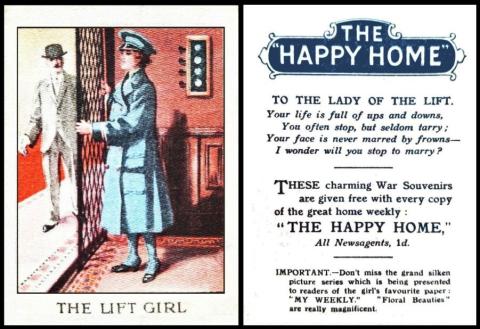
"Happy Home" [trade : magazine : UK] "Women on War Work" (1915) Un/12 - HAP-110 : HAT-5
A slight segue here but today in 1811 saw the birth of Elisha Graves Otis.
Now it is popularly said that he invented the lift - but he did not. We know of admittedly primitive lifts and hoists, powered by water, then animals or people, dating to around 300 B.C., and, by the looks of it, they were just developments of earlier ones. And as for the first counter-weighted elevator designed to only transport humans to another level of a building, that was built in 1743, for none other than King Louis XV of France.
What he invented, in 1853, was a safety device that prevents lifts from falling if the cable fails. In fact he had earlier invented a railway safety brake, using a similar principle. It is said that how he came to apply this to lifts came about when he was working at a bed factory in New York; they needed to lift heavy equipment up to the top floor by hoist and he suggested using his invention. This sounds rather odd, and I wonder if there was not some kind of accident, covered up, that led to them needing a safer way.
Anyway he was very impressed by the way his device worked, and so were they - and by 1853 he had not only left their employ but set up manufacturing safety lifts. Somehow he suddenly realised that the new fangled elevators were controlled by a cable as well, and so he designed a way to retrofit his device to those. And, in 1857, the first "safety elevator", not the first lift, was installed, at E.V. Haughwout & Co., in New York City.
Sadly he died, of diphtheria, just a few years later, on the 8th of April, 1861, aged just forty-nine.
Now our card is not a card, it is a silk, and it was issued with a magazine, called "The Happy Home", which I have not been able to track down. The set is untitled, but has been decided to show women replacing men who were off to war. In fact, if you look at the reverse it appears the title was going to be "A War Souvenir" - though it also appears that the war changed the direction of the set, as some of the cards, namely "The Baker", "The Lamplighter", "The Lift Girl", "Red Cross Nurse", and "The Ticket Collector" do not mention the war at all in the verse. And though "The [Tram] Car Conductor" also has no reference to the war within the verse, it was only in wartime that this became a job suitable, or even permissible, for a women. And the first one was Mrs. G. Duncan, who started in 1915. This set me off on a tangent to find the first women who did the other things -
-
The first licensed female taxi driver in London was Shirley Preston, but not until 1967. However in 1917 a Miss Susan Dudley Ryder actually became London's first female taxi driver, having passed all the driving tests, but, unlike Ms. Preston, not gaining the current "Knowledge".
-
The first known female firefighter in the United States was Molly Williams, a former slave, who joined a volunteer fire company, in New York City, in 1815. The first record of women fire fighters in England were students at Girton College, Cambridge, in 1879. And we know that there were women fire fighters in the First World War, but not much about them.
It is first catalogued in our original British Trade Index as :
The "Happy Home"
Periodical. All paper-backed silks, issued about 1910-1915.
- WOMEN ON WAR WORK (A). Sm. 68 x 51. See No.9 under D.21. Unnd. (12) ... HAT-5
Now after this there is a list of the silks, but I have done this a different way, as each one has a little verse on the back that seems to be completely unrecorded.
- The Baker [The Baker] -
Kneading and baking the bread we eat, / Clad in an overall spotlessly clean, / Never was vision half so sweet, / As you, my dainty bakehouse queen. - The Car Conductor [Tramcar Conductor] -
Queen of the tramcar ! So trim and so neat ; / Radiant your smile every day as we meet. / "Fare !" is your welcome, in tones sweet and low, / And we repeat "Fair ? Yes, decidedly so!" - The Fire Woman [The Firewoman] -
They said it wasn`t women`s work / They said the danger you would shirk, / What empty words they spoke ! / For when the warning bell rang out / You showed your worth beyond all doubt, / And, warning fire and smoke, / You did your duty like the best - / You faltered not - you stood the test. - The Lamplighter [The Lamp-Lighter] -
At dusk you light me on my way / Lest my unwary feet should falter, / Perhaps - Who knows ? - some other day / I`ll lead you, blushing, to the altar. - The Lift Girl [To the Lady of the Lift] -
Your life is full of ups and downs, / You often stop, but seldom tarry : / Your face is never marred by frowns - / I wonder will you stop to marry ? - The Munition Worker [Munition Worker] -
Maiden fair in cap and apron / Making shells by day and night / Yours is an heroic labour / In the cause of truth and right. - The Ploughwoman
True Lady Bountiful art thou, / Winning the war behind the plough : / Wresting from Nature Britain`s food, / "Doing your bit" as a Briton should. / O, may your harvest be rich and grand, / And success attend on the work of your hand ! - The Postwoman [Postwoman] -
Bearer of tidings of sadness or joy, / Anxious are they that list for thy tread. / What do you bring me ? News of my Boy ? / Or is your message one that I dread ? / Good news to-day ! Oh, thank you for that, / Pass along, Postwoman - rat-tat-tat. - Red Cross Nurse [Nurse] -
O woman ! in our hours of ease, / Uncertain, coy and hard to please / When pain and anguish wring the brow, / A ministering angel thou. - The Taxi Driver [The Taxi-Driver] -
You will meet her everywhere in London town, / And in every busy city up and down ; / She keeps pur business moving with her dimple and her curl, / And we couldn`t do without her now - the courteous taxi-girl ! - The Ticket Collector [The Ticket Collector] -
"Why do you do it, miss ?" said I, / As I passed through the turnstile. / "That a man may fight !" was her reply, / Given with a winning smile. / "Maid, will you marry me?" quoth I, to tease, / All that she answered was "Ticket. please !" - The Window Cleaner [Window Cleaner] -
In your little blouse of khaki and your dainty trouserettes, / You`re the nicest bit of fluff I`ve ever seen, / Though you`ve donned our nether garments, / you`re not blooming suffragettes, / And we love you `cause you keep our windows clean.
I have to say that some of these verses are a bit patronising. Though the reference to Suffragettes is rather exciting, seeing that ot was only the way that women took up the mantle of the men as they were called up that led to women, or certain woman, anyway, getting their way, and getting the vote. But it was fun seeing all the cards - and I also found out by doing so that the names on the back are slightly different, so they are recorded above too.
By the time of our updated British Trade Index, the list of silks has been moved to the accompanying handbook, and the main entry simply reads :
The "Happy Home"
Periodical. Paper-backed silks, issued 1910-1915.
- WOMEN ON WAR WORK (A). 68 x 51. Unnd. (12) See HH-9 ... HAP-110
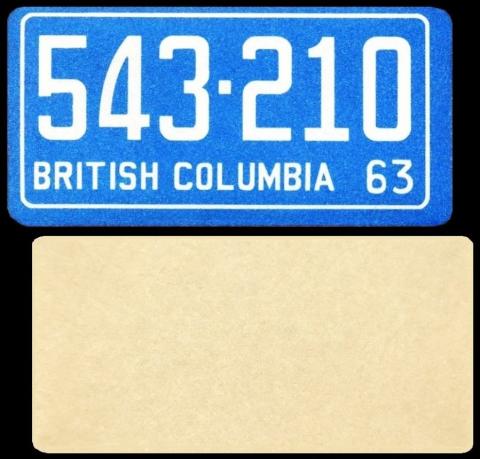
General Mills [trade : cereal : O/S - Minneapolis, USA] "License Plates - Canada" (1953) Un/12
British Columbia Day is celebrated on the first Monday of August every year, and it celebrates all the different people who have come to make it what it is, wherever they have come from, whatever their beliefs.
At first it was colonised by Native Americans, for millions of years, pretty much until the Europeans came calling with an idea to make it their land, rich as it was with natural resources.
And it was the British, who went to war with America over where the boundary of the State of Oregon ought to lie, that first started the steps to create the State of British Columbia. Once this crisis was sorted out to mutual approval, in 1846, two colonies were constructed, these being Vancouver Island, and British Columbia - though there was still the odd shaurie due to the fact the Vancouver Island was stated to be a colony in 1849, but British Columbia did not become one for almost another decade.
Shortly after that, it was decided to merge the two anyway, and that happened in 1866. And British Columbia joined Canada on the 10th of July 1871, which would seem to have been a more fitting day that today for the celebrations. In fact I have been unable to find anything about why they celebrate today.
I wanted British Columbia Day but could not find a card right until Friday - but then a reader sent me this, which is great, for many reasons.
The first interesting fact is that, despite what you may have thought when you first scrolled down and hit the picture, this is not a Topps card, it was issued with "Wheaties - The Breakfast of Champions", a cereal produced by General Mills.
The second thing is that some sites will tell you that Wheaties copied Topps, whilst others say that Topps borrowed the idea from Wheaties.
The truth is that neither of these companies issued the first license plate card - that honour goes to Goudey Gum, years earlier, between 1936 and 1939. Next up came Topps, but not until 1949-50. Then there was a gap, filled by a company called Merley`s Candy, who issued their version in 1952. This was followed, the very next year, by Topps, again, and by "Wheaties" - and also "Cracker Jack", who used some of the same plate numbers as were on the "Wheaties" cards. As did "Leader Candy", slightly later, in 1955.
Now there were four series of the "Wheaties" miniature licence plates, some on metal and some on card. They were issued in with the cereal, just in the box, but you could also get any set sent to you if you sent General Mills twenty-five cents, and a box-top from off the packet to prove you had bought their product. And they came in different groups, namely :
- "Continental United States" - four sets of twelve, forty-eight plates in all. The sets were "Eastern US", "Midwest US", "Southern US" and "Western US"
- "Territories and Possessions" - one set of ten plates - to include Alaska, Canal Zone (actually Panama), The District of Columbia, the Dominican Republic, Guam, Hawaii, Italy-Military, Maharajah, the Philippines, and the Virgin Islands. At this point we ought to point out that this set predates the statehood of Alaska and Hawaii, which is why the sets above are only of forty-eight cards
- "Canada" - one set of twelve plates - to include Alberta, British Columbia, Manitoba, New Brunswick, Newfoundland, Northwest Territories, Nova Scotia, Ontario, Prince Edward Island, Quebec, Saskatchewan, and the Yukon Territory,
- "Old World & Europe" - one set of ten plates - Cuba, Denmark, Egypt, Iran, Portugal, Malta, Monaco, the Netherlands, Switzerland, and Turkey.
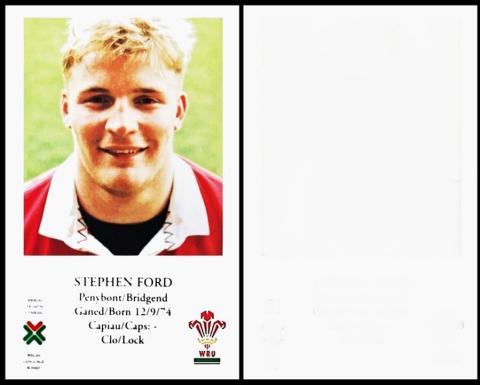
The Welsh Language Board [trade/commercial : promotional items : UK - Wales] "Welsh Rugby Squad" (1995) Un/30
Now this card did not come out so good, so if anyone has a better front, of anyone in any of the series, so long as its shows the fact that it is in both English and Welsh, I would be grateful of a scan.
Why we have this is because today marks the centenary of the founding of Plaid Cymru, now known as The Party of Wales, but founded as Plaid Genedlaethol Cymru, which, in English, meant The National Party of Wales. Despite the word "National", they lean to the left, and to supporting the Welsh Nation to stay true to itself.
Despite this, their early campaigns were to preserve the Welsh language, and more than that, to make it the only language officially spoken in Wales, hence this card; they picked up their more political agenda, calling for Welsh Home Rule, later.
They first attempted to have a representative in the Houses of Parliament at the 1929 General Election, standing in the General Election as the Member for Caernarvonshire. But it took until 1966 until Gwynfor Evans won their first seat at Westminster, though as of today they hold four seats there, and have over two hundred representatives amongst the principal local authorities.
As far as The Welsh Language Board, who issued this set, and several others, they were founded in 1993, but, in 2004, the First Minister of Wales decided to abolish it. There were lots of fights, but in the end they had to cede, and it failed to exist by the end of March 2012. However it was replaced, by a very similar organisation, called the Welsh Language Service. They are currently trying to encourage every business in Wales to have a Welsh option on their signing and their literature, and so far it is going well.
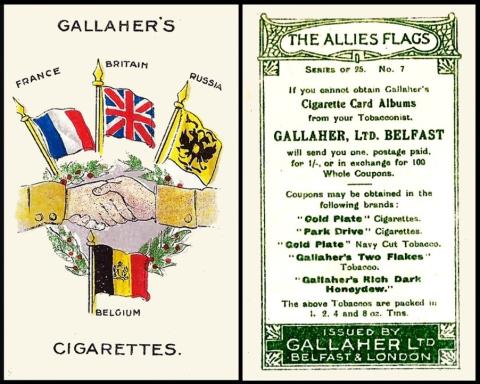
GALLAHER Ltd. [tobacco : UK - Belfast & London] "The Allies` Flags" (1914) 4/25 - G075-120 : G12-12
Now you may be wondering why I have this card today, as the first day of the First World War I is usually considered to be either June the 28th, 1914, when Archduke Franz Ferdinand, the heir to the Austro-Hungarian throne, was assassinated - or July the 28th, 1914, when Austria-Hungary declared war on Serbia.
However today saw the same Austria-Hungary declare war on Russia, whose flag is shown on the above card. Now Russia was allied to Serbia, and had been so for some time; in fact, in 1907 a "Triple Entente" declaration had been set up which promised certain countries would support the other if a war ever broke out that involved another member of the alliance. These fell into small groups, Russia, Serbia and France - Britain, France and Belgium - France, Britain and Russia - and Britain and Japan. There was one more group, consisting of Germany, Italy and Austria-Hungary, but they had already complained bitterly about these alliances, none of which they were part of, and all of which they felt could start to take over their lands and way of life. And, if we think about that, not only were they right, but this may have been the very seeds of the First World War,.
The grand fact about Russia was her size. She had the largest population, three times as many people as Germany, and a much larger army, with what is estimated to have been over five million people on standby as reserves. The problem was that these people were, for the most part, farmers and labourers, and Russia was not set up to make arms and armour. So a lot of those men, an awful lot, were killed, very early on, which led to bad feelings against those in charge, and ultimately, to the Russian Revolution of 1917, which saw the long term leaders overthrown and the communists come to power.
This set is first described in our original Gallaher reference book, RB.4, published in 1944, amidst another World War. It is catalogued as :
- 1914. 25. ALLIES FLAGS, THE (titled series). Size 2 1/2" x 1 1/2". Numbered 1-25. Fronts printed in full colour by lithography. No backgrounds or margins. Subjects titled and "Gallaher`s Cigarettes" in various positions. Backs printed in green, no descriptions. "If you cannot obtain Gallaher`s Cigarette Card Albums," etc, and "Issued by Gallaher Ltd., Belfast & London.
This set exists on :-
A. Grey-white card B. Creamy card.
By the time of its next appearance, in our World Tobacco Issues Index, over a decade later, the description has shrunk, to just :
- THE ALLIES FLAGS. Sm. Nd. (25). ... G12-12
And there is not a mention of the different colours of board. This must have been important to several collectors though as in our updated World Tobacco Issues Index the entry reads :
- THE ALLIES FLAGS. Sm. Back on (a) cream (b) white. Nd. (25). ... G075-120
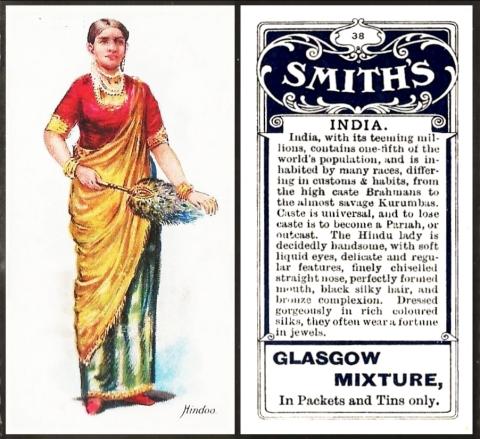
F & J. SMITH [tobacco] "Races of Mankind" (1900) 38/50 - S84-14.E
Today is #NationalHandLoomDay, and nowhere in the world is the hand loom so much of the daily way of life as in India, where the day is primarily celebrated.
At first, hand looms may appear to be a sign of repression, and female slavery, but actually the reverse is true. Most weavers are female, that is true, but their skill at the loom allows them to clothe and provide for their family, and also gives them status in the community.
As for the fact that the loom is operated by hand and not by machine, this too is a good thing, for it means that rural women can learn a trade and have means of employment even in areas where electricity is either intermittent, or non existent.
Something else you may not have considered is that the hand loom is much more eco-friendly than one which can only work by gobbling up electricity which is better used for medical and other purposes.
This is quite a recent awareness day, and it dates back to 2015, though it also celebrates the Swadeshi Movement, a group of people who began to meet on the 7th of August, 1905 and were concerned that the older trades were being forgotten, when they could provide employment, especially for women, who may otherwise be reliant on marriage for their future. They also realised that there must be something done to safeguard the industry, and promote it, overseas - as less than a hundred years ago there had been, suddenly, a huge problem, with the sudden rise of the mechanical hand loom, especially in Britain and in America, which had led to a great loss in revenue for the industry in India, during which the only alternative for women had been to set down the loom and find alternate employment, or to starve along with their family.
Our card was chosen because we have mentioned this set before but never shown it. And the lady featured is "A Hindoo", who have always been well renowned for their skill with the handloom, making elaborate sarees for themselves and also for sale. Just like the one on the card.
As we never had a Smith`s reference book, this set has quite a write up in our original World Tobacco Issues Index, namely :
- RACES OF MANKIND. Sm. Nd. (40). Multi-backed, 15 wordings - see Ha.483 and X1/Ha.483
a) Series title on front
b) Front without series title
A. "Cup Tie" Cigarettes
B. Cut Golden Bar "Twilight" Brand
C. Cut Navy Tobacco}
D. "Evergreen" Cigarettes
E. Glasgow Mixture
F. "Glory`s Reward"
G. "Goodwill" Virginia
H. "Harvest Moon" Cigarettes
I. Oriental Cigarettes
J. "Regimental" Cigarettes
K. Special Straight Cut Cigarettes
L. "Studio" Cigarettes
M. Sun Cured Mixture
N. "Trilby" Cigarettes
O. "Wild Geranium" Cigarettes
This is virtually identical in our updated version except for back F, which has been altered to "Glory`s Reward Cigarettes" - that the handbook reference is now H.483 - and, of course, that there is a new card code, of S548-360.
Now as for X1/Ha.483, that is a list of the backs and it is rather confusing. Obviously not all the backs had been recorded with all the numbers, but some must have been, perhaps in a contemporary magazine. So I will have a think of how to work on that through the weekend.
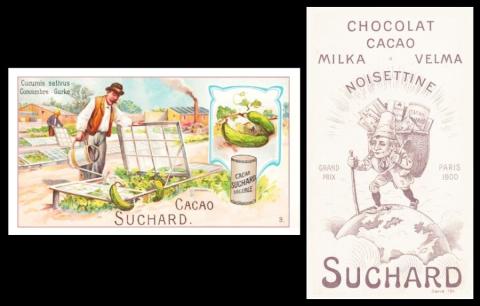
Lets end with a spot of fun, and generosity. For today is #SneakSomeZucchiniOnToYourNeighboursPorchDay
The idea behind this is that if you grow zucchini, which we call courgettes, as do the French, or even similarly shaped vegetables like gherkins or cucumbers, you sneak out with a bagful and put them by the door of your next door neighbour, as a free gift. You never say, or that would spoil the surprise, though they only have to look over the fence to see your plants.
Now I failed dismally to find a card of a zucchini or a courgette so here we have a cucumber.
This is one of twelve cards, the others being :
- Asparagus - Asperge - Spargel
- Lycopersicum - Tomate
- Bela Tellovif - Navels de Tellow - Tellower Rubchen
- Tuber - Truffe - Truffel
- Cucumis Sativus - Concombre - Gurke
- Cynara Cardunculus - Cardon - Cardone
- Morchella - Morille - Morchel
- Cucumis melo - Melon - Melone
- Cichorium - Chicoree - Endive
If anyone can provide the names on cards 4, 6 and 7, please do!
This week's Cards of the Day...
added a few more illustrations to our list of sets issued in Augusts past.
The earliest set that we know of that we can positively tie to an August release is Wills "Ships" - the set of "50 new designs" that were issued in 1896. I hoped to add one of these to our gallery during this week, but have not tracked one down yet. So if any reader would like to oblige by sending a front and back scan, please do. I am not fussy about which ship we feature.
At first I thought that August was going to be a slim month, but it got better as it went along.
We know of only three sets issued in the Augusts between 1900 and 1910, and all came from W.D. & H.O. Wills, namely "Locomotive Engines and Rolling Stock" (1903), "Arms of the Bishopric" (1907), and "Drum Horses", which was issued overseas, in India, with their `Scissors` brand (in 1909).
However we know of thirteen between 1910 and 1916, and sixteen between 1923 and 1929 - and that period also includes 1926, when we have recorded the highest total of sets in any August - five sets, and from five different makers - these being Gallaher "Cinema Stars", Hignett "Historical London", Lambert & Butler "Pirates & Highwaymen", Player "Football Caricatures by RIP", and Wills "New Zealand - Early Scenes & Maori Life"
The 1930s gave us a total of twenty-eight sets, and then there was one, so far the latest set we know of, which is Player`s "Dogs Heads" - silver backgrounds - issued in Ireland in 1940
And so to our clue cards, which were ...
Saturday, 26th July 2025
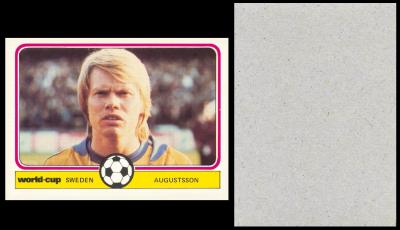
This set was not issued in August, and neither was our man, Bo Augustsson, who was born on the 28th of December 1949, in Mala, Sweden. That seems to suggest his father was called August, and he was August`s son. For often that is how names arise.
He played football as a child, just with his brothers, but it was not until he moved to Atvidaberg that he even considered joining a team. He was seventeen then. Perhaps it was more that the local team, Atvidaberg FF, had just been promoted, and was almost certainly in the news.
In 1972 he moved to Holland, when he joined FC Den Haag, but only stayed there for two years, then turned up back with Atvidaberg FF. He then moved to Landskrona BoIS, but became injured, I have not found out how. He seems to have stopped playing football then and gone to work in a school, but his talent with teaching led him to go back to Landskrona BoIS, as a youth coach, in the 1980s, and that led him to become a coach for several clubs, both in the Nordic region and as far away as Abu Dhabi and South Africa.
His two sons are also footballers.
This set was issued to celebrate the 1978 World Cup, which took place in Argentina, and the home side won, beating the Netherlands 3-1 in the final, after extra time. The Brazilian team was third, as they beat Italy 2-1 in the third place play-off.
Sweden, the team for which our man turned out, were in group C with Spain, Austria, and Brazil, but they lost 1-0 to Austria and Spain and only managed to draw 1-1 with Brazil. However, they do have quite a record in the World Cup, twelve appearances to date, the first being in 1934, which was only the second ever tournament (Italy won, beating Czechoslovakia 2-1), and their highest result being runner up in 1958, where they lost to Brazil, 5-2. And they were pretty much unbeatable in Europe through the late 1940s and early 1950s.
This set, for some reason, never had text on the reverse, it is just plain and grey, in a variety of shades. This makes some new collectors think they were packet issues, and shun them.
However, they were issued inside packets - though there is a curious anomaly with these, because the front of them simply says "HANNAH`S present world-cup football"; it is only on the back that it mentions Monty, and confuses us still more by having four different languages - Dutch, English German, and French. As far as where the cards were issued, this turns out to be France, Denmark, and Canada, though they must have been issued in England too as the English section reads : "Join the MONTY CLUB and order an album by sending 10 empty packets plus 50p in stamps. Address MONTY CLUB - POB 173 - LEIDEN/Holland."
Sunday, 27th July 2025
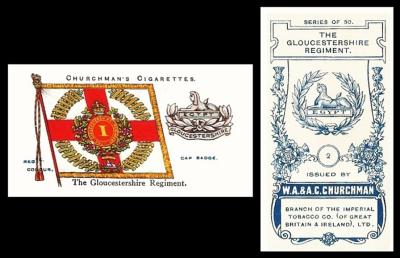
This set was issued in August but also in August 1782 came the decision that all regiments would no longer be named after their colonels, but forever linked with counties. Hence we have one of those counties, Gloucestershire.
The Gloucestershire Regiment began as Colonel Gibson's Regiment of Foot, in 1694 - though nowhere near Gloucestershire, but down in Portsmouth. Its first foray into battle came in 1705, during the War of Spanish Succession, which you probably think you have not heard of, but it included such battles as Blenheim and Ramillies.
For almost another fifty years, almost every time a new colonel came along the name was changed, but in 1742 all this changed and the regiment was renamed to the 28th Regiment of Foot.
In August 1782, there was another, even bigger change, for it was decided to link all our regiments with counties, though many of them had no connection with the county to which they were linked. The idea was that local men would be more likely to join a local regiment, should conflict occur. Therefore our regiment was renamed to the 28th (North Gloucestershire) Regiment of Foot, and given a companion, the 61st (South Gloucestershire) Regiment of Foot - this having been formed in 1758 as the 61st Regiment of Foot.
Our original Churchman reference book, issued in 1948, lists the set as :
- 123. Aug. 1912. 50 REGIMENTAL COLOURS AND CAP BADGES. (Untitled series). Size 2 11/16" x 1 7/16" or 67 x 36 m/m. Numbered 1-50. Fronts lithographed in colour. Backs in blue, no descriptions. Printed by Mardon, Son & Hall. Also issued by Player.
The Player set was actually issued earlier, in 1910, and it comes in three versions - one covers Regular Regiments and has a blue back , whilst one covers Territorial Regiments and can be found with both blue or brown backs. I thought we had shown one of those before but will have to hunt tomorrow. And I will also try to find out how the cards were selected for our Churchman version - unless anyone knows and can save me hunting.
As usual, the description in our World Tobacco Issues Index is shorter, just :
- REGIMENTAL COLOURS AND CAP BADGES. (A). Sm. Nd. (50).. See H.73. ... C82-26
And it remains the same in our updated version, save a new card code, of C504-340.
Monday, 28th July 2025
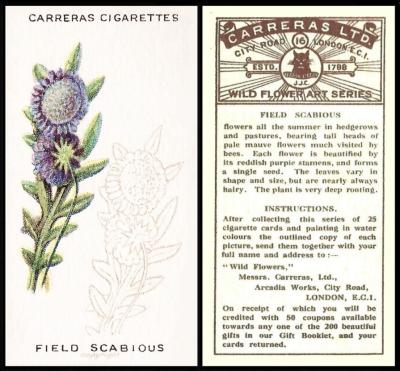
Here we have Field Scabious, or Knautia Arvensis, a perennial flowering plant that is part of the honeysuckle family. And it is a valuable source for providing succour to many different insects, plus, even, the Marsh Fritillary butterfly and the Bee-hawk moth.
It is at its peak in August, then, during the same month starts to go to seed. At which time you will be able to watch the seeds being stolen by an army of goldfinches, who enjoy them very much.
It likes to grow amidst the grass, loves chalklands, and objects to clay and heavy soil And you will see its bright heads pop up between May and August, in which month it starts to go to seed.
As for the name scabious, that was given it in the fourteenth century, when it was discovered that it could help heal sores caused by the bubonic plague. In fact it is a derivative of the Latin word, "scabere", which means to scratch. And as far as the "Knautia", well that comes later, from the seventeenth century German botanist, Christian Knaut.
For all that, the plant is very little known, and much under appreciated.
This is actually a set which seems to consistently go beneath the collector`s radar too, and yet it, like the flower it represents, is just as delightful, and charming. And on the reverse there is a description of the wild flower, along with its habitat, the month you are most likely to see it, and sometimes, even its uses.
Below this there are instructions, namely "After collecting this series of 25 cigarette cards and painting in water colours the outlined copy of each picture, send them together with your name and address to :- "Wild Flowers", Messrs. Carreras, Ltd., Arcadia Works, City Road, LONDON E.C.1. On receipt of which you will be credited with 50 coupons available towards any one of the 200 beautiful gifts in our Gift Booklet, and your cards returned".
I have to say that Carreras seem to have been aiming at the higher class end of their smokers here, for how many readers of this page could be able to reach for their watercolours and paint this outline in? Not many, I am sure. I do have watercolours, somewhere, though I imagine if I found them they would probably be unusable due to their great age.
There is another thought, too, for as I said before, this set is quite scarce, and yet of all the ones I have seen I do not remember seeing any which were coloured in. So perhaps the collectors consigned their returned cards to the bin or to the fireplace when they came back, and just concentrated on spending their coupons? Maybe this is why they are so scarce....
They are described in our original World Tobacco Issues Index, without much excitement, as :
- WILD FLOWER ART SERIES. Sm. Nd. (25). ... C18-71
And this is exactly the same text in our updated version, just with a new card code :
- WILD FLOWER ART SERIES. Sm. Nd. (25). ... C151-395
Tuesday, 29th July 2025
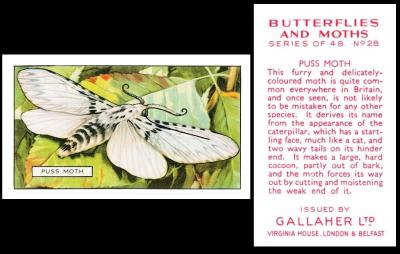
Our lovely moth, also known as Cerura vinulais, gains its name from its furry feel, which is, indeed, reminiscent of a feline friend. Though our card gives another reason, that "It derives its name from the appearance of the caterpillar, which has a startling face. much like a cat, and two wavy tails on its hinder end."
It always seemed to much prefer the southern parts of the British Isles, but, perhaps due to loss of habitat, or even changing climates, it is starting to move ever steadily northwards. It does not seem to mind where it lives, as long as there is easy access to food, for themselves and their caterpillars, and the food of choice are tree leaves, especially aspens, poplars, and willows.
The moth is, dare I say, not that spectacular in looks, it is grey, and the markings are either dark grey or black, save three lines in orange that slide down from its head to its wings - but the caterpillars are amazing. They may start as little dark brown lines on the backs of the leaves, but yellows and greens soon start to arrive, so that they better blend in with their surroundings, harder for predator insects, or birds, to spot, and in August they are at their brightest, with red and yellow faces, and a brown saddle, edged in yellowy white, extending down their backs and girthed around their stomachs.
The species was first described in 1758, by Carl Linnaeus - but they took much longer to appear on cards. Most collectors cite its rookie card as number nine John Player`s "Butterflies and Moths", which was issued in 1904, a set also circulated by Adkin, with the same numbers, but in 1924, twenty years later. You can compare both versions at the New York Public Library, to which they were donated by Jefferson Burdick. The cards do give a different Latin name though, of Dieranura Vinula, which I have not been able to track down elsewhere. And before I race ahead, the 1911 set by the same title, but issued by Imperial Tobacco Co. of Canada, is not the same as these.
The moth then goes off into its chrysalis, as the next time it pops up on cards is not until the 1930s. Its first flight comes courtesy of Ogden Ltd`s "Colour in Nature", card 19, which only shows the caterpillar - and makes it look pretty freakish. That is followed by two appearances in 1938, both of which only show the moth - those being our card, issued in August, and the larger sized Wills "Butterflies and Moths", issued in October.
Our set is first catalogued in our original Gallaher reference book, RB.4, published in 1944, as :
- 1938. 48. BUTTERFLIES & MOTHS (titled series). Size 2 1/2" x 1 7/16". Numbered, 1-48. Fronts, printed in full colours by offset-litho, black marginal lines, white margins, and subjects titled. Backs, printed in maroon, with descriptions, "Issued by Gallaher, Ltd., Virginia House, London & Belfast." Printed by E.S.A. Robinson Ltd., Bristol
Needless to say most of this information is not carried forward to our original World Tobacco Index, where all we get is :
- BUTTERFLIES & MOTHS. Sm. Nd. (48). ... G12-76
And that remains the only text in our updated volume, apart from a new card code, of GO75-550
Wednesday, 30th July 2025
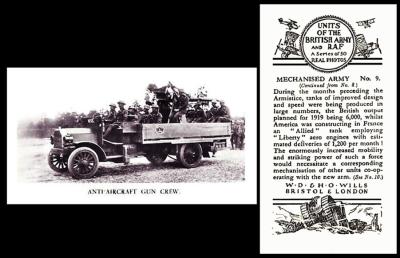
This is a most curious set, especially given the date of issue, for by then the events mentioned on the cards were almost ten years on. This has led a lot of collectors to imagine that it was to be one of, if not the first set issued after the Armistice, but then, for some reason, that honour went to the first series of "Do You Know", which appeared in September 1922. And it is also rather striking that after that there was no true military series until "Air Raid Precautions", which was issued in August 1938.
It was only overseas, and only in New Zealand, that military sets continued to appear in Wills` packets - the first of which was "V.C.`s" (issued in March 1926), "Warships" and "Aeroplanes" (both June 1926), a reissue of John Player`s "Regimental Standards and Cap Badges" (March 1928), and then our set in August of the same year.
It is first described in our original reference book RB.16 – "The Cigarette Card Issues of W.D. & H.O. Wills Parts I, II, and III (revised) and Part IV", first published in 1950. The entry reads :
- 336. 50. UNITS OF THE BRITISH ARMY AND R.A.F. Fronts : Glossy photoprints in black and white; many faded cards are found , some in an almost sepia shade. Backs in black, with descriptive text, Wills` name at base. Issued in New Zealand, between 1925-30
In our original World Tobacco Issues Index, the set appears under section 5 of the Wills` listings, devoted to "Other Export Issues", and sub section B, for "English Language Issues 1923-30. Issued chiefly in New Zealand, some series in Malaya, Malta and elsewhere." It is catalogued as :
- UNITS OF THE BRITISH ARMY AND R.A.F. Sm. Black and white photos. Nd. (50). See RB.21/200-336.A ... W62-478
This is pretty much identical in our updated World Tobacco Issues Index, except that "Black and white" has been reduced to "B & W", and there is a new card code of W675-686.
Now I have not forgotten the sneaky surprise of seeing RB.21, which is our original British American Tobacco reference book - nor of the thrill that that code is suffixed by an "A", which usually denotes there is at least one other issuer. However it does not turn out to be quite as exciting as that, for the text reads :
- 200-336. UNITS OF THE BRITISH ARMY AND R.A.F. The recording in W/356 requires to be amended as follows :
A. Wills` Overseas issue. Back in black with descriptive text
B. Anonymous issue, with plain back
And it seems universally regarded that the anonymous issue was but proofs, removed from the printer`s - though we do have a date of issue, and that proves that the set was printed in England and only then exported overseas.
Thursday, 31st July 2025
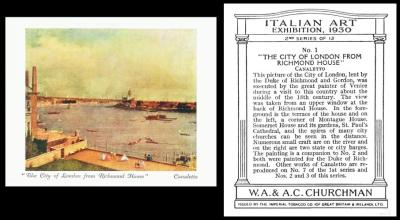
This painting was done in 1747, and it shows a far different skyline to that we would see today from this same spot. And it has a sibling, looking the other way, called "Whitehall and the Privy Garden from Richmond House", which you can see as card two of this series.
The reason for the titles is that the paintings were commissioned by Charles Lennox, who was the Second Duke of Richmond. And we also know that they were painted by Canaletto in situ, from inside the house, looking out of a window. The terraces we can see before us belong to Richmond House, and, over the wall to the left, to Montagu House. We know that in the original design the Thames was much more crowded, and there were larger boats, plying their trade, which were not included in the final painting. We also suspect that the red roofed Royal Barges were added later, to give it more cachet and value.
Richmond House was sadly destroyed by fire, less than fifty years later, in 1791 but luckily these paintings, and some others, were saved. And, though most sites will tell you that they are now "in a private collection", I have discovered that the owner of that collection is, delightfully, the Eleventh Duke of Richmond, who lives at Goodwood House.
The Italian Art Exhibition was held from Wednesday January the 1st to Saturday March the 8th, 1930, at The Royal Academy of Arts, Burlington House, Piccadilly; and the correct title was the "Exhibition of Italian Art 1200-1900". It had joint patrons, the Kings and Queens of the United Kingdom and Italy. Admission was a shilling and sixpence on Monday to Saturday, but, for some reason not Friday, which cost a rather swingeing five shillings. Or you could get a season ticket for one pound one shilling, which included every day of the week, even those more expensive Fridays.
All this information can be viewed online, because the official catalogue has been digitised by the Royal Academy and uploaded to the web.
As I have not featured this set, or the first series before, and there is relatively few cards in each set, I have listed them both below. However, once the first series makes an appearance that part of the list will be relocated.
| ITALIAN ART EXHIBITION, 1930 | - 1st series of 12 : | |
| 1 | "The Virgin and Child" | - A. Baldovinetti |
| 2 | "Fortuna Inconstans" | - Giovanni Bellini |
| 3 | "The Birth of Venus" | - Botticelli |
| 4 | "The Calumny of Appelles" | - Botticelli |
| 5 | "Madonna and Child" | - Botticelli |
| 6 | "The Lovers" | - Paris Bordone |
| 7 | "The Grand Canal and House of the English Consul, Venice" | - Canaletto |
| 8 | "The Duke of Urbino" | - Piero Della Francesca |
| 9 | "The Duchess of Urbino" | - Piero Della Francesca |
| 10 | "La Bella" | - Titian |
| 11 | "Portrait of a Lady" | - Raphael |
| 12 | "Angelo Doni" | - Raphael |
and :
| ITALIAN ART EXHIBITION, 1930 | - 2nd series of 12 : | |
| 1 | "The City of London from Richmond House" | - Canaletto |
| 2 | "Whitehall from Richmond House" | - Canaletto |
| 3 | "View of Murano" | - Canaletto |
| 4 | "La Madonna della Candeletta" | - Carlo Crivelli |
| 5 | "St. George & the Dragon" | - Francia |
| 6 | "The Tempest" | - Giorgione |
| 7 | "The Miracle of St. Dominic" | - Benozzo Gozzoli |
| 8 | "The Virgin & Child with St. Anne" | - Leonardo da Vinci |
| 9 | "The Angel of the Annunciation" | - Melozzo da Forli |
| 10 | "Virgin and Child with three Angels" | - Piero della Francesca (School of) |
| 11 | "Portrait of a Lady" | - Antonio Pollaiuolo |
| 12 | "Portrait of an Englishman" | - Titian |
The sets first appear in our original Churchman reference book RB.10, with a rather lengthy description, of :
- 81. 12. ITALIAN ART EXHIBITION, 1930. (titled series). Size 3 5/16" x 1 9/20" or 80 x 62 m/m. Numbered 1-12. Fronts printed by letterpress, 4-colour half tone process. Backs in dark green, with descriptions. Printed by Mardon, Son & Hall.
- 82. 12. ITALIAN ART EXHIBITION, 1930. Described "2nd Series of 12". Other detail as item (81), but different subjects.
They next feature in our original World Tobacco Issues Index as :
- ITALIAN ART EXHIBITION, 1930. Lg. Nd. ... C82-59
1. "1st Series of 12"
2. "2nd Series of 12"
And it is further shortened in our updated World Tobacco Issues Index, to a single line, reading :
- ITALIAN ART EXHIBITION, 1930. Lg. Nd. 1. "1st Series of 12" 2. "2nd Series of 12" ... C504-545
Friday, 1st August 2025
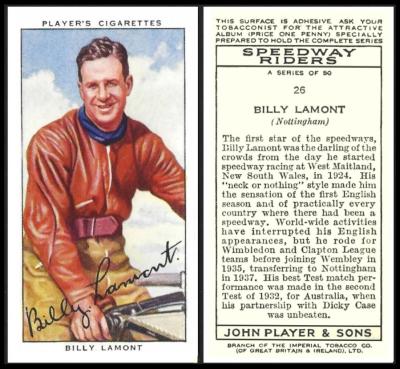
Funnily enough, Wilfred Steward Lamont, showing here, was also born in August, in 1908, on the 12th. And he was still a teenager when the first motorcycle thundered round a dirt track at the West Maitland Showground in December 1923, and, most people consider, gave birth to the sport of speedway which would so enthrall him as he grew.
West Maitland was also the first place he raced, in 1924, when he was only sixteen. Four years later he was sailing to England as part of a team of fellow Australians set to show their skills. Once in England he became "Billy" Lamont, or "Cyclone", and he decided to stay in England too, joining the "Dons", based at Wimbledon, in 1930.
Before that he had been shown on two cigarette cards. His first is always said to be card 15 of Ogden`s "Famous Dirt Track Riders", issued in 1929, the year he was voted "Most Popular Speedway Rider", and that also claims him to be "Probably the greatest of all the Dirt-Track riders, "Cyclone Billy Lamont" was born in Newcastle, New South Wales He started racing in 1924 at Maitland the first track built in Australia, and since that time has broken nearly every record in Australia, besides winning many of the most valuable trophies, Since coming to England to ride for International Speedways, he has broken several of our track records, including that of Stamford Bridge. When in action he is without exception the most thrilling rider to watch, as he invariably goes into the bends on full throttle."
The next card of him was issued in 1930 by J.A. Pattrieouex, part of the set called "Dirt Track Riders". This gives him yet another birthplace. The text there tells us that he is : "An amazingly popular and daring rider who is regarded by many experts as the most spectacular Australian who has ever ridden on a Speedway. Born in Rutherford, New South Wales, 22 years ago. At the age of 16 he held all track records at Newcastle, Australia. Later he put up new records at the Adelaide Speedway Royal. He came to this country with a determination to show the English "boys" a thing or two and he succeeded. His riding provoked admiration wherever he raced and before long he held dozens of records over here He has a distinctive style of riding which earned him the name "Round the Fence Lamont". Usually mounted on an A.J.S. machine."
I tried to find the reason behind that nickname. and think it refers to a very risky practise, when fans would hold their programmes out towards the track, and, as he raced past, ever and ever closer, the wind, and sometimes parts of his bike or body, would knock those programmes out of the hands of his adoring fans, and flutter them to the ground.
He also continued to ride for his home team, Australia, with whom he won two early dirt track world championships, way before they were called that, or run under any of what would become official rules. And he won the "Silver Helmet" in 1931. But in 1933 he joined the Clapton Saints, and two years later the Wembley Lions. Indeed, he rode for many teams until the start of the Second World War.
During that time he appeared on R. & J. Hill`s "Sports Series", issued in 1934, along with cards of fellow riders F. T. Hatton, Frank Arthur, F. W. Dixon, and one card which is reputedly just entitled "Motorcyclist". If anyone has that I would be interested to hear more. The set was issued in two formats, only one of which has a descriptive text, and the card of him in that version, number 2, reads : ""BILLY LAMONT, nicknamed "Cyclone" taking a bend at speed, in connection with Dirt Track Racing".
One of his last card appearances before the Second World War is in Godfrey Phillips "Sportsman - Spot the Winner" (1937, the same year as our card) where he is card 31. However there is no descriptive text here, just a game on the reverse in which you tell which horse is first past the post by moistening the card with the tip of your finger. And it would have been quite useful to hear of the later years of his career, for they are sketchy. We only know that in 1939 he returned to Australia, and did not even take his bike. And when he got there he got a job in a sugar refinery. He does not even appear to have joined the forces, and yet he was only thirty-one years old.
Our set, which proves that speedway was at an all time high, and so deserving of a full set only showing the riders. It is first catalogued in our original John Player reference book, RB.17, published in 1950, as :
- 181. 50. SPEEDWAY RIDERS. Small cards. Fronts in colour, with reproduction of autographs. Backs in grey, with descriptive text, adhesive. Home issue, August 1937., with special album.
By the time of its next appearance, in our World Tobacco Issues Index, six years later, the description has shrunk, to just :
- SPEEDWAY RIDERS. Sm. Nd. (50) ... P72-174
And that remains the same in the updated version, save a new card code, of P644-352.
